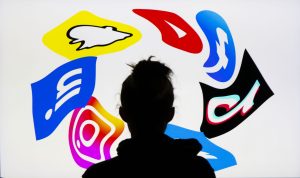- Slug: Sports-Teen Athlete Mental Health, 2500 words.
- 3 photos available (thumbnails, captions below).
- Graphic available
By David Bernauer
Cronkite News
PHOENIX – The Arizona sun beat down on the pavement in May, hot enough to make any walking person uncomfortable. Summertime was on the horizon. Before the thermometer reached scalding temperatures, the Readinger residence hosted a graduation party.
Addi Readinger appeared set to begin the next stage of her life after her senior year at Millennium High School in Goodyear. Some guests quietly noted she looked thinner. They likely chalked it up to the cardio required to compete in track and field, cross country, basketball and soccer.
Gold and black graduation decorations adorned the house, and the smell of food permeated the air. Guests munched on hot dogs, hamburgers, mac ‘n’ cheese and chips. Readinger ate none of it.
She always had been the center of attention on her track teams, winning just about everything, and to her discomfort, today was no different.
“Everybody was like, ‘What’s your next step? What are you gonna do?’” Readinger said. “I had a graduation party and didn’t graduate. I was so ashamed that I didn’t tell anybody.”
Nor did they know the former 3.8 GPA student taking honors and AP classes had only attended school about once a week, and only for a portion of the day.
“I don’t think they would even believe me,” she said.
As a result of a dizzying amount of external pressures, Readinger developed an eating disorder. In about a month, she dropped from 136 pounds to 102 pounds.
An epidemic
Nearly half of Americans struggle with a mental illness for some period of time before they reach adulthood, and young athletes are no exception. Athlete adolescents are reporting “higher levels of negative emotional states” than their non-athlete counterparts, according to a 2015 study from the National Athletic Trainers’ Association.
“Keeping up with (your) mental health is something that you really have to rely on, especially when it comes to school and doing sports,” said Malakai Dotstry, a former track and field athlete and football player at Youngker High School in Buckeye. “Because if your mental health is not right, you’re not going to do your work at your best.”
Competing with a group or team is generally seen as a positive for self-worth, but stress is present over individual performance, playing time, dealing with aches and sprains and bruises, or pleasing teammates, coaches and parents. These factors can compound themselves with the normal stressors for teenagers, like turning in school assignments on time, working a job after school or making time for friends.
Readinger grew up in Terre Haute, Indiana, just across from the Wabash River that separates Indiana from Illinois. She was a natural athlete who excelled in every sport she tried in the red, white and navy blue colors of North Vigo High School athletics.
“Nobody could ever score,” Readinger said of her defense in basketball. “They’d always put me on the lead scorer for the other team.”
However, running was always her strong suit.
“I won every single track meet in high school, every single track event I won,” she said. “And then when it came to regionals, sectionals, things like that, sectionals I always won. Regionals I would go in, I would make it to state. As a freshman, I made it to state. And then my sophomore year, I made it to state again.”
Readinger had a busy schedule balancing all her sports and extracurricular activities. From freshman to junior year, a typical day included waking up at 5:30 for practice, attending school during the day, more practice in the evening, work from 6 to 10 at night, finally catching some sleep around midnight, then rinse and repeat.
Despite how hectic this could seem for anyone, let alone a teenager, Readinger managed to make it all work. She had the friends she grew up with and her church group for support and was succeeding academically and athletically. Everything was going well. But midway through her junior year, her family moved to Arizona and Readinger no longer had her support systems in place.
As a result, life took a turn for the worse.
The downside of connectivity
The 2010s marked the advent of the social media age. The ability to connect with anyone in the world was available at the push of a button. A time so unimaginable even 20 years before, it will likely go down as one of the major eras (and maybe errors) in human history.
As teenagers, a big part of sticking to social norms evolved into being active on social media. According to a 2022 Pew Research Center study of 13- to 17-year-olds, 46% of survey respondents admitted they were online “almost constantly” and 35% said they were active on at least one social media platform such as Instagram, TikTok Facebook, YouTube or Snapchat “almost constantly.”
“I feel like I used to care a lot more about social media and what people thought about me definitely through high school because that’s what you’re expected to do,” Readinger said.
While Gen Z is lambasted for being addicted to TikTok, many believe there are also benefits to perusing places like Reddit and Twitch.
For one, social media can provide teens an outlet to express themselves more freely and discover new interests. It also allows all people, regardless of age, to keep up with current events around the world. However, it is not without concerns.
Social media usage has been linked to higher rates of depression, anxiety and lower self esteem. Seeing images of a projected perfect life can make one’s perception of their own seem not as exciting and their bodies not fit enough in comparison.
“For any teenager, social media plays at least 50% of the cause for their mental health struggles,” said Rajani Rastogi, who worked as a social worker at Hamilton High School in Chandler for almost nine years. “Their self-esteem suffers because of what other people are doing and saying online.”=
At Millennium, social media provided no positives for Readinger. She saw images of her old friends, family and school halfway across the country.
“When it came to school, being depressed, sitting by myself at lunch and just being so miserable, it made me so sad,” Readinger said. “I’d cry to myself every single day at lunch.”
Three months after her life had been picked up and dropped in a new environment, the COVID-19 pandemic struck. Schools, businesses and everywhere you once could go for social outings was now shut down. Away from Terre Haute, Readinger struggled to feel comfortable in her new surroundings. She felt no semblance of control over her life. All she wanted was her old life back, to return to Indiana, to have the friends and family she’d always known, to be in familiar company. With little left in her hands, she realized there was still one thing left that she could manage: her food intake.
Her struggles led to an eating disorder. When school reopened, she rarely attended, going maybe once a week. Readinger would still go to her new job as a waitress at Augie’s Sports Grill in Goodyear, where she made a few new friends while regularly logging 60-hour weeks in the process.
“My parents … my siblings were like, ‘She’s being rebellious, she’s not going to school, she’s not doing this, she’s not doing that,’ and my friends could tell something was up,” Readinger said.
Sleep issues
Designed to keep users scrolling as long as possible, social media usage is also linked with sleeping less. The blue light emitted from electronic devices is effective at altering internal clocks, according to the National Library of Medicine, and can ultimately contribute to mental health issues.
The National Sleep Foundation defines nine hours of sleep per night as sufficient rest, eight hours as borderline, and anything less than eight hours as insufficient rest for adolescents. In their study, they found only 7.6% of students get enough sleep to qualify as having sufficient rest. The Journal of Adolescent Health reports that 22.8% of students slept six hours or fewer per night, which would align with a 2015 study from Current Sports Medicine Reports that 15-21% of athletes experience depression. Chronic sleep disturbances are one of the main culprits behind teenagers getting a lack of sleep. They can range anywhere from restless leg syndrome, night terrors or sleep apnea, but most common in adolescents is insomnia.
“If you try to sleep outside of your kind of natural circadian sleep window, that’s when you encounter health-related problems,” said Dr. Luis Buenaver, the Director of the Johns Hopkins School of Medicine’s Behavioral Sleep Medicine Program. “What’s difficult is in high school, they get started at 7 or 7:30, or 8 o’clock, and it works for the adults. But for a lot of high school kids, there turns out to be a misalignment between when they need to be asleep because of school.”
Regularly sleeping fewer than six hours a night can lead to a number of health issues. The association between lack of sleep and risk for depression and anxiety is hard to ignore.
“So people that have chronic sleep disturbance, have a four-to-tenfold risk increase for depression and depressive symptoms,” Buenaver said.
Everybody knows the feeling of grogginess and the longer time it takes to comprehend information when not sleeping enough. It’s tiring, and everything is moving a little faster while the mind is lagging a step behind. The mental toll of not getting enough sleep is already present, along with the physical one as a lack of sleep has been linked to an increased risk of injury while playing sports.
One study published in the Journal of Pediatric Orthopaedics found the best predictor of a young athlete suffering an injury was how much sleep they got per night. Of the 160 athletes surveyed, 65% who slept less than eight hours a night reported experiencing a significant injury, while 31% who got equal to or more than eight hours of rest reported one.
Across all sports, especially contact sports such as football, a lack of sleep means an increased risk of concussion. The Journal of Bone and Joint Surgery says insufficient sleep can lead to “lower baseline neurocognitive functioning, worse neurocognitive impairment, worse post-concussive symptoms, and prolonged post-concussion recovery.” Those few tenths or hundredths of a second it takes to process and react to information can mean the difference between getting your helmet knocked off or avoiding a 300-plus-pound lineman.
“If you have a bad few nights, or if you sacrifice sleep because of other things, then you could put yourself at risk,” Buenaver said. “You’re not going to be as sharp as you would be otherwise if you’d had a good night’s sleep. And so you elevate your risk like for twisting your ankle, you could fall, you could collide.”
Reaching out
Of course, it is possible for students to seek help from someone like a school counselor or social worker. But even with all the resources available, it doesn’t mean they have the familiarity with these resources to feel comfortable reaching out. Going into a vulnerable state and telling them everything going on can be hard because they don’t know the person.
“I think maybe some athletes feel like, ‘Oh, I can handle things on my own.’ They feel more tough, or they rely upon the coach and their team,” Rastogi said. “It depends on everyone’s comfort level.”
And if they are comfortable with someone like trusted family or friends, they don’t want to feel like they’re being a burden.
“I didn’t want to be problematic. I didn’t want anybody to worry about me. I didn’t want to be troublesome,” Readinger said. “My parents would try to help but I didn’t want their help and I kept pushing them away. I don’t think I really ever asked anybody for help.”
It’s important for coaches to foster an environment where athletes feel comfortable enough to come forward with their problems. Through 21 years of coaching, Keiko Yoshimine has seen everything from a winless season to a runner-up for a Coach of the Year award. Yoshimine and Kristin Hoffner, who is a principal lecturer at ASU teaching sports psychology, were head coach and assistant coach, respectively, of the girls varsity basketball team at Paradise Valley from 2004 to 2012.
“When I was at Paradise Valley High School with Kristen, she was obviously in sports psychology and was a huge part for us,” Yoshimine said of her former assistant. “And that was one of the best things is that we had her right there. So we didn’t need to hire outside help. She was the help, you know, and she was really tapped into that, whether it be visualization, or combating negative image or individual thoughts, or bad self-talk.”
Simply put, they were a bad team at first. Routine losses of 30 points or more and a 1-47 record across two seasons highlighted their struggles. Often, players would come to Yoshimine and Hoffner complaining about not only the mental stress of losing so often and by so much, but bullying from classmates who had seen the scores.
Some players had other issues outside of basketball which would affect their performance on the court. Namely, there was an incident where one girl had been cutting and another who had been suffering from an eating disorder and passed out during practice.
“It was always about keeping the lines of communication open,” Yoshimine said. “There were a few kids that have had to have sit-downs with parents and talk about what we’ve been seeing or what we think is happening. You’re trying to give that kid support.”
Yoshimine and Hoffner weren’t experts on the mental health of teens, just a pair of high school basketball coaches in their mid-twenties. Sometimes if an athlete wasn’t showing up to school, they would personally pick them up at their homes, drive them to school, go to their day jobs and come back to the school later to run practice. Despite all the effort, there was only so much they could do from the sidelines.
“We recommended mental health clinicians, we got the parents involved, we pulled in school counselors, and we did whatever we could with that,” Hoffner said.
Added Hoffner: “To keep them mentally sane, it was a challenge. We had to throw this idea that winning was everything completely out. We’d congratulate them for getting a good stop or getting a good defensive play. We would call a timeout if the other team didn’t score a wide-open layup in two minutes and celebrate like we won the game.”
\)
The challenges paid off, though. Two years after their 1-47 stretch, Paradise Valley posted a winning record.
The teenage years come with inherent stress and anxiety, and while social media can affect teenagers in positive ways, it can also be detrimental to their mental health. Lack of sleep can also impact not only cognitive ability and physical performance but also lead to psychiatric illnesses. A reluctance to use available resources can exacerbate an athlete’s depression, anxiety, or other mental health ailments.
Awareness of athlete mental health has changed. Gymnast Simone Biles and swimmer Michael Phelps have been praised for coming forward about their mental health issues. But at the same time, the stigmas persist.
“It takes you a while to figure out that you’re even feeling that way and realize it’s a problem, and at that point, you’re probably too embarrassed because you’ve been telling people for so long it wasn’t a problem,” Readinger said.
For more stories from Cronkite News, visit cronkitenews.azpbs.org.


